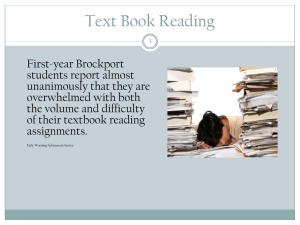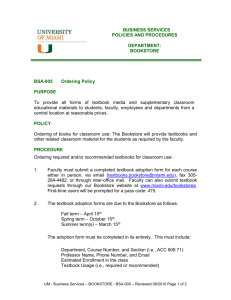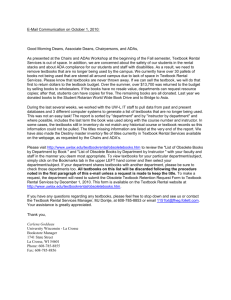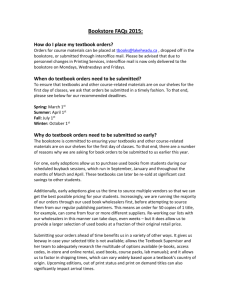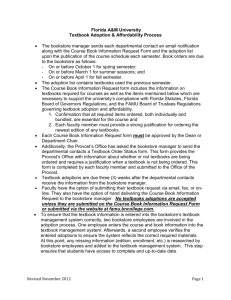CSCC Textbook Affordability plan
advertisement
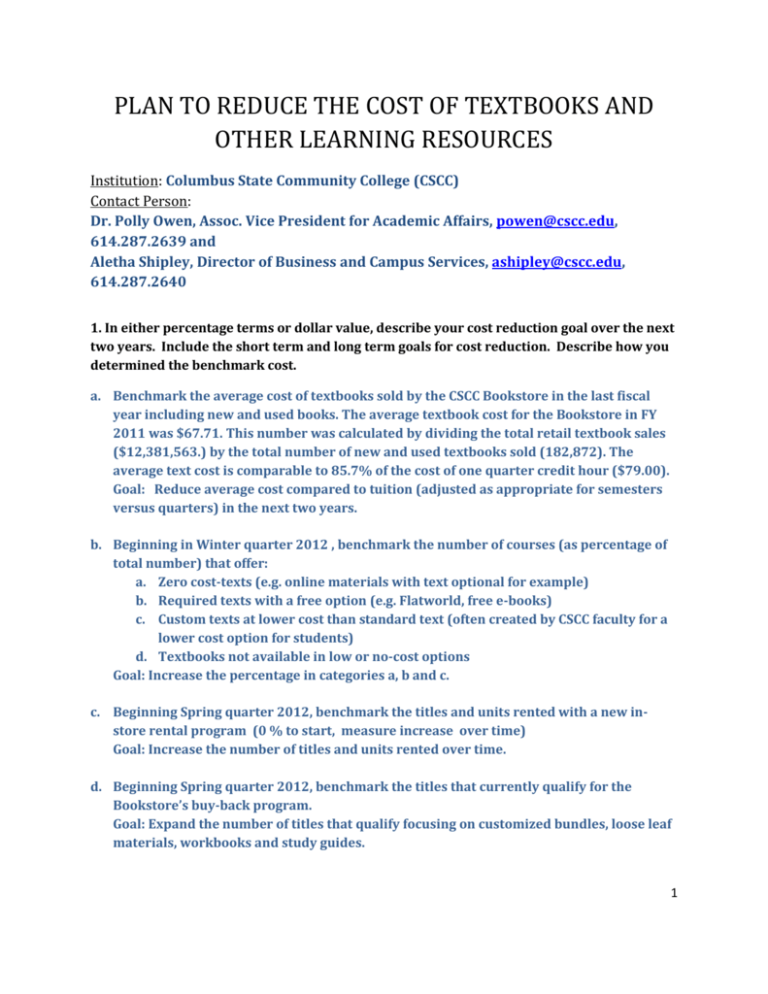
PLAN TO REDUCE THE COST OF TEXTBOOKS AND OTHER LEARNING RESOURCES Institution: Columbus State Community College (CSCC) Contact Person: Dr. Polly Owen, Assoc. Vice President for Academic Affairs, powen@cscc.edu, 614.287.2639 and Aletha Shipley, Director of Business and Campus Services, ashipley@cscc.edu, 614.287.2640 1. In either percentage terms or dollar value, describe your cost reduction goal over the next two years. Include the short term and long term goals for cost reduction. Describe how you determined the benchmark cost. a. Benchmark the average cost of textbooks sold by the CSCC Bookstore in the last fiscal year including new and used books. The average textbook cost for the Bookstore in FY 2011 was $67.71. This number was calculated by dividing the total retail textbook sales ($12,381,563.) by the total number of new and used textbooks sold (182,872). The average text cost is comparable to 85.7% of the cost of one quarter credit hour ($79.00). Goal: Reduce average cost compared to tuition (adjusted as appropriate for semesters versus quarters) in the next two years. b. Beginning in Winter quarter 2012 , benchmark the number of courses (as percentage of total number) that offer: a. Zero cost-texts (e.g. online materials with text optional for example) b. Required texts with a free option (e.g. Flatworld, free e-books) c. Custom texts at lower cost than standard text (often created by CSCC faculty for a lower cost option for students) d. Textbooks not available in low or no-cost options Goal: Increase the percentage in categories a, b and c. c. Beginning Spring quarter 2012, benchmark the titles and units rented with a new instore rental program (0 % to start, measure increase over time) Goal: Increase the number of titles and units rented over time. d. Beginning Spring quarter 2012, benchmark the titles that currently qualify for the Bookstore’s buy-back program. Goal: Expand the number of titles that qualify focusing on customized bundles, loose leaf materials, workbooks and study guides. 1 2. Describe how you plan to achieve this goal. Please be specific and indicate strategies that will sustain these savings and if the efforts will be immediate, continuing or long term. The College will continue the work of the Textbook Affordability Committee, begun in June 2011, which has cross campus representation including members from the Library, Instructional Technologies and Distance Learning (ITDL), the Bookstore, and faculty from Arts and Sciences, and Career and Technical divisions. This committee will be involved in planning and monitoring many of the activities addressed in this section. Immediate Strategies: a. Purchase and implement Verba software to provide students with a comparative shopping tool, to assist them in securing the best price and format for their needs. b. Expand “reserved” textbooks in Library for student use. Make sure that high enrollment/introductory course textbooks are available for students to reserve. c. Develop a textbook adoption timeline to encourage early adoptions that are sustained for a minimum of one year. This allows the College more time for negotiation with vendors and more buyback opportunities for students. d. Increase the availability of used textbooks (Bookstore and faculty strategies) including expansion of the Bookstore’s buy-back program. This will require a multi-term commitment to the text. e. Assist faculty and students in transitioning to e-books. Offer information about how to use e-books to take notes, underline, highlight, research, and study. Develop online modules to help students and faculty understand their options for texts and to show students how to use e-texts effectively. f. Organize a Spring 2012 conference on textbook affordability to discuss and share best practices of various Ohio institutions in reducing the costs of textbooks and other learning material. Long-term Strategies: a. Establish an in-store textbook rental program. (Currently, the Bookstore has an online rental program.) An in-store rental program will increase access to textbook rentals for students who do not shop online, and who receive financial aid. The Bookstore will also increase the titles available for rental, beginning with high-enrollment/introductory course textbooks. In order to guarantee that students return rented texts at the end of the term, CSCC will establish and implement textbook rental policies. 2 b. Develop a textbook adoption process that addresses affordability for students, including creating a guideline that targets affordability as one primary factor for faculty to consider in choosing a textbook. c. Explore/develop process for negotiating with publishers to lower costs of textbooks purchased by the Bookstore. d. During student orientation and the student success courses, educate students about textbook costs, rental and buyback programs, e-books, and other information to help them take advantage of opportunities to spend less on textbooks. 3. Describe how you plan to measure the success of your goal. How do you expect to enforce compliance with the policy you implement to achieve cost reduction? a. The Textbook Affordability Committee, in conjunction with the Office of Academic Affairs, will develop a faculty textbook adoption process that targets affordability. The Committee will evaluate how best to assure increased collaboration between faculty and the Bookstore to focus on affordability; and establish the need for early, multiple-term adoptions, and two-year textbook commitments when possible. b. The Bookstore will establish an in-store rental program by Spring quarter 2012 and measure the use of the program, number of titles available, and units rented over time. The staff will set rental program goals for a two-year time period. c. The Bookstore will review current buyback procedures, identify and increase the number of textbooks in buyback program to include materials not currently available for buy-back including customized bundles, loose-leaf texts, workbooks, study guides, and CSCC custom texts. d. The Textbook Affordability Committee will work with staff from the Library, ITDL, the Bookstore and faculty representatives to create, pilot and implement learning modules on access to textbooks and other learning materials for the Student Success course. An overview of this information will also be incorporated into Student Orientation. The College will also create online modules on how to use e-texts effectively (delivered via Blackboard for courses that offer e-texts). e. The Bookstore will purchase and implement Verba (by Spring quarter) allowing students to shop comparatively on-line and view affordable options for each title. Assure that at registration, students can link to the Bookstore web site to view the costs/options for course textbooks. f. The CSCC Library will work with faculty to expand its textbooks on reserve, beginning with making sure that 100% of high enrollment/introductory course textbooks are on reserve for student use. 3 g. The College will recognize faculty and staff success in reducing the costs of textbooks to students through CSCC Team Awards, annual appraisals and other College recognition. 4. Describe how you plan to monitor and sustain the success of your goal. a. The Textbook Affordability Committee will monitor the progress and success of the proposed activities. A review of the overall project will be conducted at the end of each term and provided to the Office of Academic Affairs and Business and Campus Services. b. The CSCC Bookstore will incorporate textbook affordability plans and outcomes into unit goals. c. As textbook affordability is added to the College’s Scorecard, division monitoring will assure attention to this goal. Submit your plan electronically to dmccoy@regents.state.oh.us no later than December 1, 2011. Should you have any questions, do not hesitate to contact Darlene McCoy (614-728-3094) or Kelly Bernard kbernard@regents.state.oh.us (614-728-7637) PLEASE USE THIS REPORT FORMAT WHEN COMPLETING YOUR PLAN. 4


